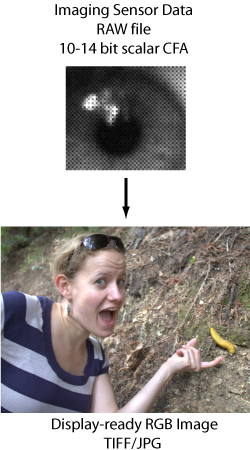Reading RAW files into MATLAB and Displaying Them

- A discussion of the nature of raw camera sensor data
- A step-by-step MATLAB guide for reading a RAW image and taking this nature into account when processing or displaying
- Linearization
- White Balancing
- Demosaicing
- Color Space Correction
- Brightness and Constrast Adjustment for Display
Processing RAW Images in MATLAB, 2013 - PDF
Files
The following files implement the code found in the paper. It is intended to be instructional and easily followed, therefor it is neither optimized for speed or memory usage, nor is it implemented as a function to simply read RAW files for your other work (though it could be easily converted into one).raw_process.m - Main script implementing code from the paper.
wbmask.m (supplemental functions)
apply_cmatrix.m
camera_matrices.txt - Direct copy of the table of XYZ-to-Cam conversion matrices for many camera models from the dcraw source code. Each entry is formatted as {"Camera Model", <black>, <saturation>, {<9 ints>} }, where the last entry is an array of row-wise entries of the matrix, times 10000.
(Test images - Note these must be converted to DNG or TIFF as per the guide. I could supply such versions here, but then you'd miss out on that important step!)
banana_slug.cr2 - Canon test image, 15MB, taken by me.
nikon_testim.nef - Nikon test image, 14MB, from rawsamples.ch, where others can be found for many various cameras.
(The following dcraw resources (or some equivalent) are only necessary for those on Linux or with MATLAB older than r2011a).
dcraw_win.c - dcraw source code unedited except for the addition of the few defines necessary for error-free compilation with Visual Studio 2008 or newer, as described in the paper, if you want to compile yourself.
dcraw.exe - A compiled 32-bit Windows executable of the above dcraw source.
Change Log
2014-5-19- Added code for lookup through the Linearization Table for, e.g., Nikon images rather than just mentioning it.
- Fixed wbmask.m to be general for any Bayer alignment.
- Simplified gamma compression from official sRGB one requiring an extra .m file to just using a common power law approximation with gamma=1/2.2.
Related Links
Steve on Image Processing - Origins of the MATLAB DNG read-in method used.Inside the CR2 Format - Great detailed analysis of the CR2 file structure and the how dcraw reads and processes it.
Manpage of dcraw
Adobe DNG Converter Downloads
DNG Specifications - Information about all the Exif tags in a DNG, plus instructions for how to linearize a DNG and more advanced ways to color correct a RAW file than explored here.